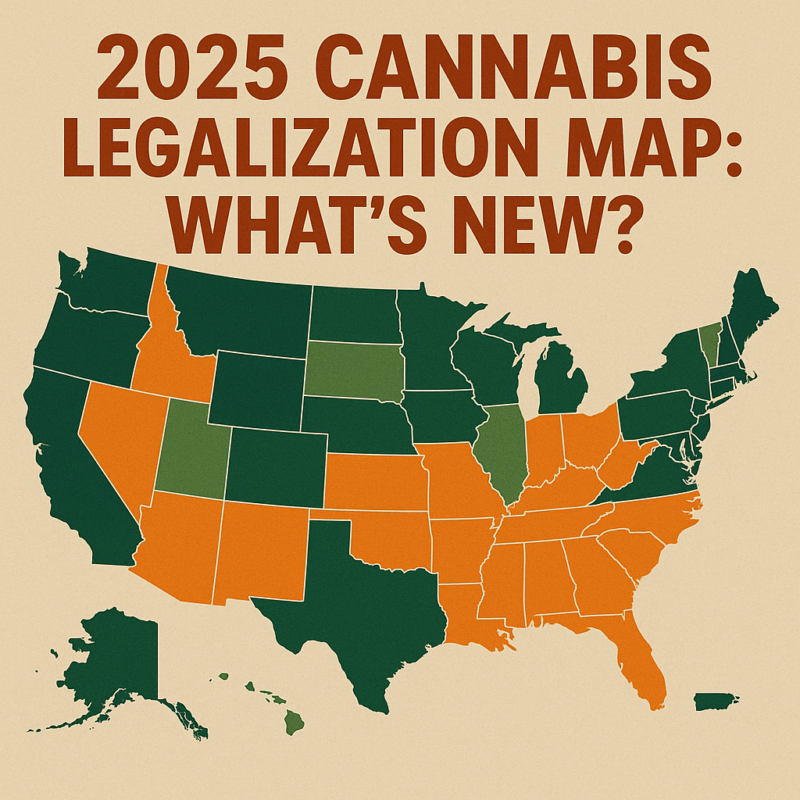
Introduction
As cannabis legislation continues to evolve across the United States, 2025 marks another milestone year for reform, regulation, and resistance. To break it all down, we sat down with Jenna Morales, a cannabis policy analyst with over a decade of experience tracking legislative changes at both the state and federal levels.
We asked Jenna to help us understand what’s new on the legalization map, where progress is accelerating, and what challenges still stand in the way.
Interview Begins
Q: Jenna, let’s start with the big picture. What’s different about the cannabis map in 2025 compared to just a year ago?
Jenna: The shift is real. In 2024, we saw momentum building—2025 is the year several key states acted. Ohio and Pennsylvania officially rolled out adult-use programs after voter-approved ballot measures. Meanwhile, South Carolina surprised everyone by passing a tightly regulated medical program.
What’s also new is the language. We’re moving away from “recreational” and “medical” toward terms like “adult-use wellness” and “regulated cannabinoid access”—an effort to normalize cannabis across political lines.
Q: Are we close to a tipping point federally?
Jenna: The pressure is building, no doubt. A few years ago, federal legalization felt like a moonshot. But now, with 40+ states allowing some form of cannabis, Congress is under more scrutiny. The SAFE Banking Act finally cleared the Senate this spring, and there’s buzz about a federal de-scheduling debate in late 2025.
But let’s be clear—full federal legalization is not a guarantee this year. What we’re more likely to see is piecemeal reform: access to banking, reclassification of cannabis, and maybe expungement incentives.
Q: Which states are now “green” that weren’t last year?
Jenna: In addition to Ohio and Pennsylvania going fully legal, New Hampshire implemented a new state-run dispensary model for adult use. It’s unique because the government controls all retail—kind of like how some states handle alcohol.
Meanwhile, Texas expanded its medical program to include chronic pain and PTSD, which is a significant step for a historically conservative state.
There’s also movement in Hawaii, which passed legislation to create a framework for adult-use sales, although we probably won’t see stores open until 2026.
Q: Any states pushing back against legalization or tightening rules?
Jenna: Yes, and it’s a critical part of the conversation. Florida’s Supreme Court approved an adult-use ballot initiative, but state officials are already signaling opposition.
In Montana, where adult-use cannabis is already legal, lawmakers proposed stricter advertising and packaging rules. There’s growing concern about “youth exposure,” so expect more marketing regulations in red states.
And some states like Idaho and Nebraska remain holdouts entirely. They’ve doubled down on bans despite neighboring states going green.
Q: Are there any surprising cannabis-friendly zones in 2025?
Jenna: Actually, yes—the Midwest. A region once seen as slow to adopt reform is now stepping up. Minnesota, Missouri, and Michigan have developed robust programs. And with Ohio’s legalization, it creates a Midwestern cannabis corridor.
Also, tribal nations are asserting more autonomy. Several Native American reservations in the Dakotas and Arizona have launched cannabis operations, creating new economic pathways while navigating both federal and state law.
Q: Let’s talk economic impact. What’s the legalization boom doing for state economies?
Jenna: States that legalize are seeing real revenue and job growth—no surprise there. But the real trend in 2025 is how they’re spending that money.
For example, New York is reinvesting cannabis taxes into communities disproportionately affected by the War on Drugs. Other states are directing funds to education, addiction services, and workforce development.
However, not all states are seeing the same return. Oversaturation, poor rollout plans, or high taxation (like in California) can hurt the local market. It’s a balancing act.
Q: What should brands and consumers watch for next?
Jenna: A few things:
- Interstate commerce discussions are heating up. If federal reform continues, brands may soon sell across state lines legally.
- Minor cannabinoid regulation is coming. Think Delta-8, THCP, HHC—those gray areas are being reeled in.
- Retail delivery and e-commerce laws are expanding, especially in tech-savvy states like California, Massachusetts, and Colorado.
For consumers, education is key. Potency, dosage, and product type still vary widely by state. Read labels. Ask questions. And support companies that invest in compliance and transparency.
Conclusion
While 2025 hasn’t brought federal legalization just yet, the cannabis map has grown greener than ever before. From expanding access in conservative states to new licensing models and reform-minded policy tweaks, it’s clear: the momentum is irreversible.
As Jenna points out, the future of cannabis isn’t just about laws—it’s about how smartly we integrate this industry into daily life. And whether you’re a brand, a patient, or a curious consumer, this year’s legalization landscape has something for everyone to watch—and navigate wisely.